
One of the most common complaints from scrubs wearers is that they do not fit. Because the standard in some hospitals and medical facilities was overlarge and loose-fitting, both professional personnel and the public came to expect that square and shapeless people wore scrubs. The whole purpose of scrubs is uniformity and ease, but baggy and floppy garments are not a requirement. If large or extra-large scrub tops are uncomfortable as well as unflattering, they can be altered to fit well and look trim.
Things You'll Need
Scrub top
Full-length mirror
Straight pins
Chalk pencil, water-soluble marker or air-erase pen
Thread
Needle or sewing machine
Scissors
Steam iron
Spray starch
Video of the Day
Step 1
Turn the scrub top inside out so that the seams are exposed. Try it on over the usual undergarments and fasten the closures from the inside, if necessary. Ask a friend to help to fit the top with pins and remind the friend to insert the pins with the pointed end down.
Video of the Day
Step 2
Insert pins alongside the side seams lengthwise, beginning 1/2 inch inside the original seams. If the garment is still too large, pin again 1 inch inside the seams. Remember, a 1/2-inch pinning will reduce the garment size by 1 inch, and a 1-inch pinning will reduce the size by 2 inches. The main idea of this fitting is to bring the sides of the garment closer to the body. If desired, increase the size of the reduction at the waist to form a more fitted garment and taper back above and below the waist.
Step 3
Continue pinning up to and through the armhole and down the sleeve seam. The amount of reduction can easily be adjusted by moving the pins farther away or closer to the seams.
Step 4
Reduce the width of the shoulders by pinning all the way around the sleeve seam, beginning with 1/2 inch and adjusting to fit.
Step 5
Ask the friend to use a chalk pencil, water-soluble marker or air-erase pen to mark the position of each pin before removing them. This marking must be clear because it will guide the sewing of new seams down the sides and around the armhole.
Step 6
Remove the garment and do not turn it right side out. Use thread that matches the garment and a needle or sewing machine to sew a sturdy seam along the marked lines made by the chalk or pen. Try on the top again after sewing to check the fit.
Step 7
Trim the seam allowances created by the new seams so that they are no more than 1/2 inch wide. Finish the raw edges with an overcast stitch. Try on the garment again, wrong side out, and pin-fit it again across the shoulder seams, if necessary. This alteration will reduce the size of the neck opening and bring the garment closer to the body.
Step 8
Stitch the new shoulder seams and try on the garment again. If it is satisfactory, trim the seam allowances as before and finish the raw edges.
Step 9
Make adjustments to the length of the scrub top. Some wearers prefer a longer top because it covers the hipline; others like a shorter length. To move the hem up or down, remove the stitching with a seam ripper or single-edge razor blade, turn up the new hem, mark it with pins and chalk, and decide on the placement of the patch pockets. These important pockets may require repositioning with a new hem.
Step 10
Move a pocket on or near the hemline by cutting the stitching that attaches the pocket to the scrub top with a seam ripper or with a single-edge razor blade. Take care not to cut the fabric. Replace the pocket at the proper position on the altered scrub top and hold it in place with pins. Mark its position as before, remove the pins, and stitch around the pocket, securing the corners with back stitches.
Step 11
Launder, dry and press the scrub top. Steam or spray-starch the seams from both inside and outside, paying special attention to any places that appear to be bulky.